BUSN20017 Effective Business Communication Essay: Workplace Dynamics
VerifiedAdded on 2022/11/24
|7
|1877
|185
Essay
AI Summary
This essay provides a comprehensive analysis of effective business communication within the workplace, focusing on the interplay between employee emotional experiences, motivation, and the impact of supervisor interactions. It explores the significance of both verbal and nonverbal communication in shaping organizational culture and employee perceptions. The essay delves into the influence of the ERT model on supervisor-subordinate communication and examines how emotional support and nonverbal immediacy affect workplace dynamics. It also discusses the role of social interactions and the importance of creating a comfortable working environment where employees feel motivated and supported. The research highlights the need for proper regulations and the implementation of strategies like the Supervisor NI model to foster positive communication and reduce workplace stress. This paper also emphasizes on the significance of understanding employees' emotional needs and implementing the ERT model to improve communication and create a positive work environment.
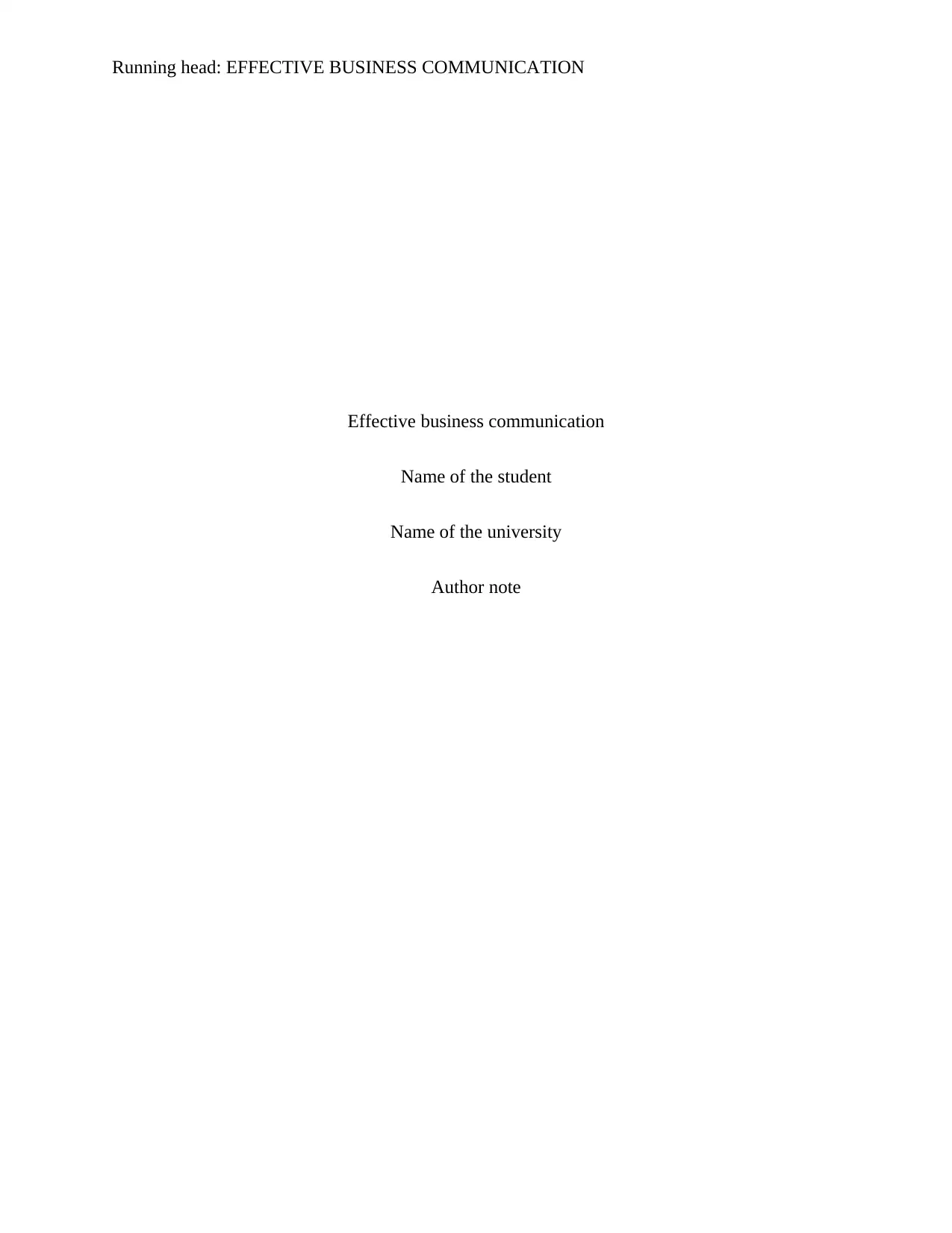
Running head: EFFECTIVE BUSINESS COMMUNICATION
Effective business communication
Name of the student
Name of the university
Author note
Effective business communication
Name of the student
Name of the university
Author note
Paraphrase This Document
Need a fresh take? Get an instant paraphrase of this document with our AI Paraphraser
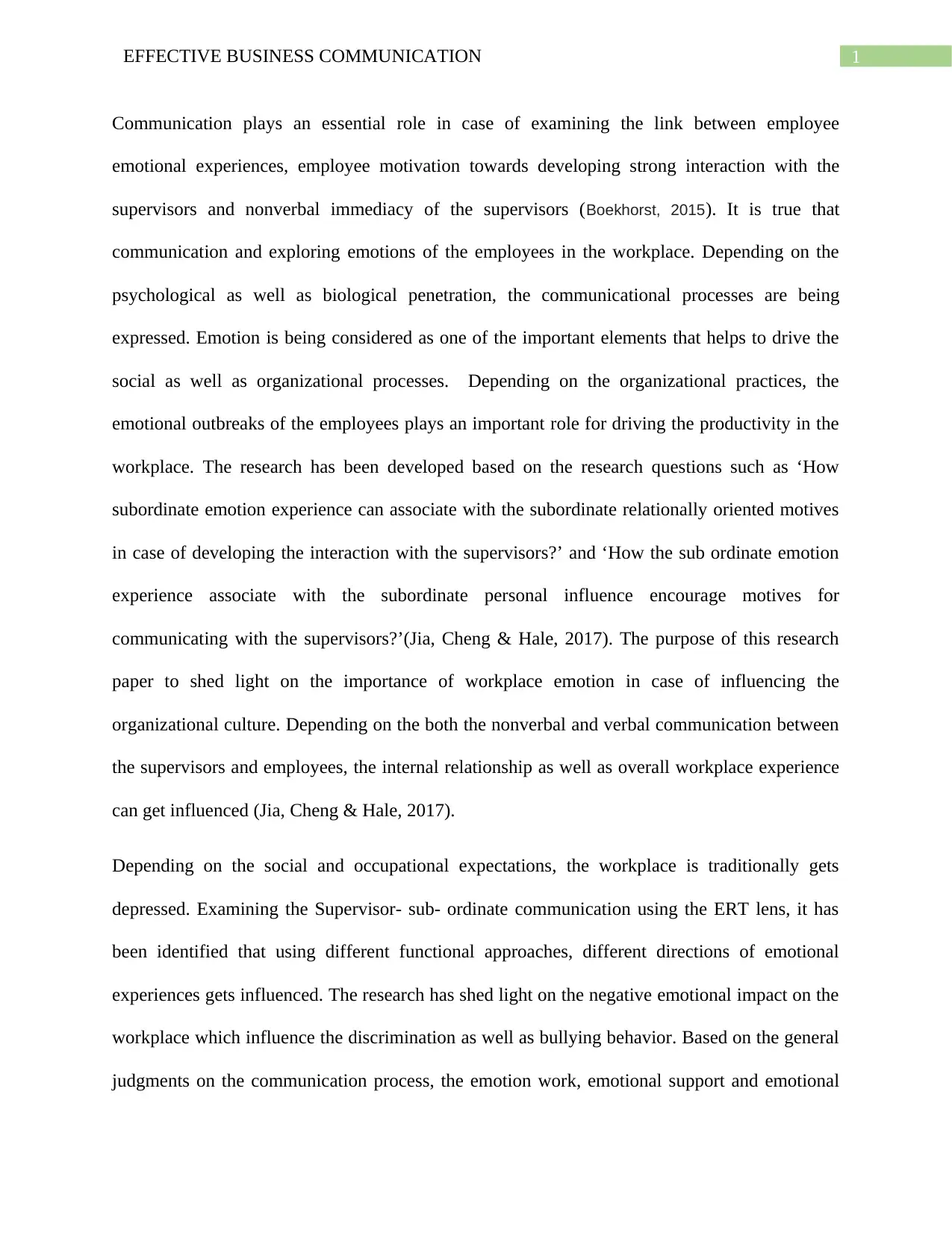
1EFFECTIVE BUSINESS COMMUNICATION
Communication plays an essential role in case of examining the link between employee
emotional experiences, employee motivation towards developing strong interaction with the
supervisors and nonverbal immediacy of the supervisors (Boekhorst, 2015). It is true that
communication and exploring emotions of the employees in the workplace. Depending on the
psychological as well as biological penetration, the communicational processes are being
expressed. Emotion is being considered as one of the important elements that helps to drive the
social as well as organizational processes. Depending on the organizational practices, the
emotional outbreaks of the employees plays an important role for driving the productivity in the
workplace. The research has been developed based on the research questions such as ‘How
subordinate emotion experience can associate with the subordinate relationally oriented motives
in case of developing the interaction with the supervisors?’ and ‘How the sub ordinate emotion
experience associate with the subordinate personal influence encourage motives for
communicating with the supervisors?’(Jia, Cheng & Hale, 2017). The purpose of this research
paper to shed light on the importance of workplace emotion in case of influencing the
organizational culture. Depending on the both the nonverbal and verbal communication between
the supervisors and employees, the internal relationship as well as overall workplace experience
can get influenced (Jia, Cheng & Hale, 2017).
Depending on the social and occupational expectations, the workplace is traditionally gets
depressed. Examining the Supervisor- sub- ordinate communication using the ERT lens, it has
been identified that using different functional approaches, different directions of emotional
experiences gets influenced. The research has shed light on the negative emotional impact on the
workplace which influence the discrimination as well as bullying behavior. Based on the general
judgments on the communication process, the emotion work, emotional support and emotional
Communication plays an essential role in case of examining the link between employee
emotional experiences, employee motivation towards developing strong interaction with the
supervisors and nonverbal immediacy of the supervisors (Boekhorst, 2015). It is true that
communication and exploring emotions of the employees in the workplace. Depending on the
psychological as well as biological penetration, the communicational processes are being
expressed. Emotion is being considered as one of the important elements that helps to drive the
social as well as organizational processes. Depending on the organizational practices, the
emotional outbreaks of the employees plays an important role for driving the productivity in the
workplace. The research has been developed based on the research questions such as ‘How
subordinate emotion experience can associate with the subordinate relationally oriented motives
in case of developing the interaction with the supervisors?’ and ‘How the sub ordinate emotion
experience associate with the subordinate personal influence encourage motives for
communicating with the supervisors?’(Jia, Cheng & Hale, 2017). The purpose of this research
paper to shed light on the importance of workplace emotion in case of influencing the
organizational culture. Depending on the both the nonverbal and verbal communication between
the supervisors and employees, the internal relationship as well as overall workplace experience
can get influenced (Jia, Cheng & Hale, 2017).
Depending on the social and occupational expectations, the workplace is traditionally gets
depressed. Examining the Supervisor- sub- ordinate communication using the ERT lens, it has
been identified that using different functional approaches, different directions of emotional
experiences gets influenced. The research has shed light on the negative emotional impact on the
workplace which influence the discrimination as well as bullying behavior. Based on the general
judgments on the communication process, the emotion work, emotional support and emotional
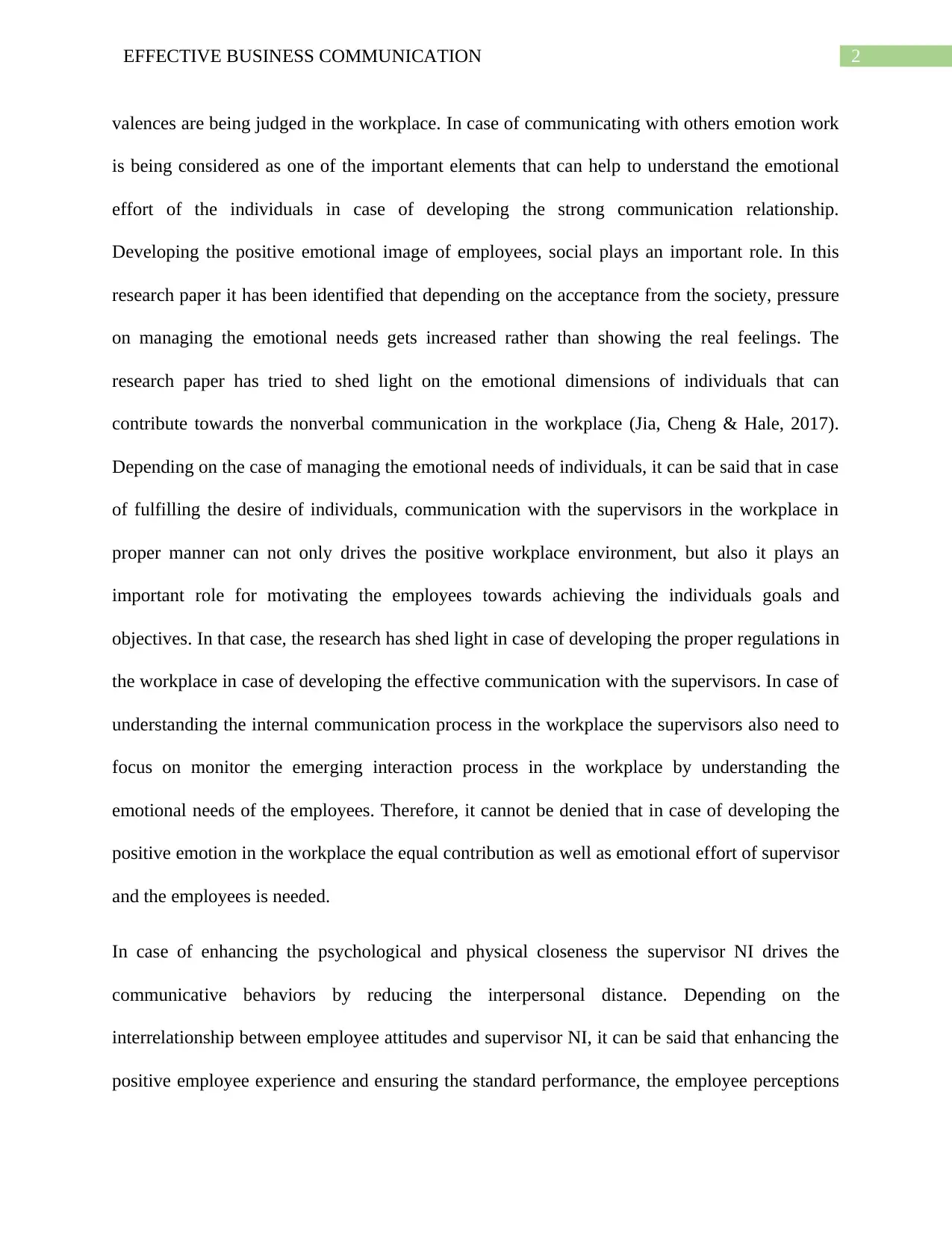
2EFFECTIVE BUSINESS COMMUNICATION
valences are being judged in the workplace. In case of communicating with others emotion work
is being considered as one of the important elements that can help to understand the emotional
effort of the individuals in case of developing the strong communication relationship.
Developing the positive emotional image of employees, social plays an important role. In this
research paper it has been identified that depending on the acceptance from the society, pressure
on managing the emotional needs gets increased rather than showing the real feelings. The
research paper has tried to shed light on the emotional dimensions of individuals that can
contribute towards the nonverbal communication in the workplace (Jia, Cheng & Hale, 2017).
Depending on the case of managing the emotional needs of individuals, it can be said that in case
of fulfilling the desire of individuals, communication with the supervisors in the workplace in
proper manner can not only drives the positive workplace environment, but also it plays an
important role for motivating the employees towards achieving the individuals goals and
objectives. In that case, the research has shed light in case of developing the proper regulations in
the workplace in case of developing the effective communication with the supervisors. In case of
understanding the internal communication process in the workplace the supervisors also need to
focus on monitor the emerging interaction process in the workplace by understanding the
emotional needs of the employees. Therefore, it cannot be denied that in case of developing the
positive emotion in the workplace the equal contribution as well as emotional effort of supervisor
and the employees is needed.
In case of enhancing the psychological and physical closeness the supervisor NI drives the
communicative behaviors by reducing the interpersonal distance. Depending on the
interrelationship between employee attitudes and supervisor NI, it can be said that enhancing the
positive employee experience and ensuring the standard performance, the employee perceptions
valences are being judged in the workplace. In case of communicating with others emotion work
is being considered as one of the important elements that can help to understand the emotional
effort of the individuals in case of developing the strong communication relationship.
Developing the positive emotional image of employees, social plays an important role. In this
research paper it has been identified that depending on the acceptance from the society, pressure
on managing the emotional needs gets increased rather than showing the real feelings. The
research paper has tried to shed light on the emotional dimensions of individuals that can
contribute towards the nonverbal communication in the workplace (Jia, Cheng & Hale, 2017).
Depending on the case of managing the emotional needs of individuals, it can be said that in case
of fulfilling the desire of individuals, communication with the supervisors in the workplace in
proper manner can not only drives the positive workplace environment, but also it plays an
important role for motivating the employees towards achieving the individuals goals and
objectives. In that case, the research has shed light in case of developing the proper regulations in
the workplace in case of developing the effective communication with the supervisors. In case of
understanding the internal communication process in the workplace the supervisors also need to
focus on monitor the emerging interaction process in the workplace by understanding the
emotional needs of the employees. Therefore, it cannot be denied that in case of developing the
positive emotion in the workplace the equal contribution as well as emotional effort of supervisor
and the employees is needed.
In case of enhancing the psychological and physical closeness the supervisor NI drives the
communicative behaviors by reducing the interpersonal distance. Depending on the
interrelationship between employee attitudes and supervisor NI, it can be said that enhancing the
positive employee experience and ensuring the standard performance, the employee perceptions
⊘ This is a preview!⊘
Do you want full access?
Subscribe today to unlock all pages.

Trusted by 1+ million students worldwide
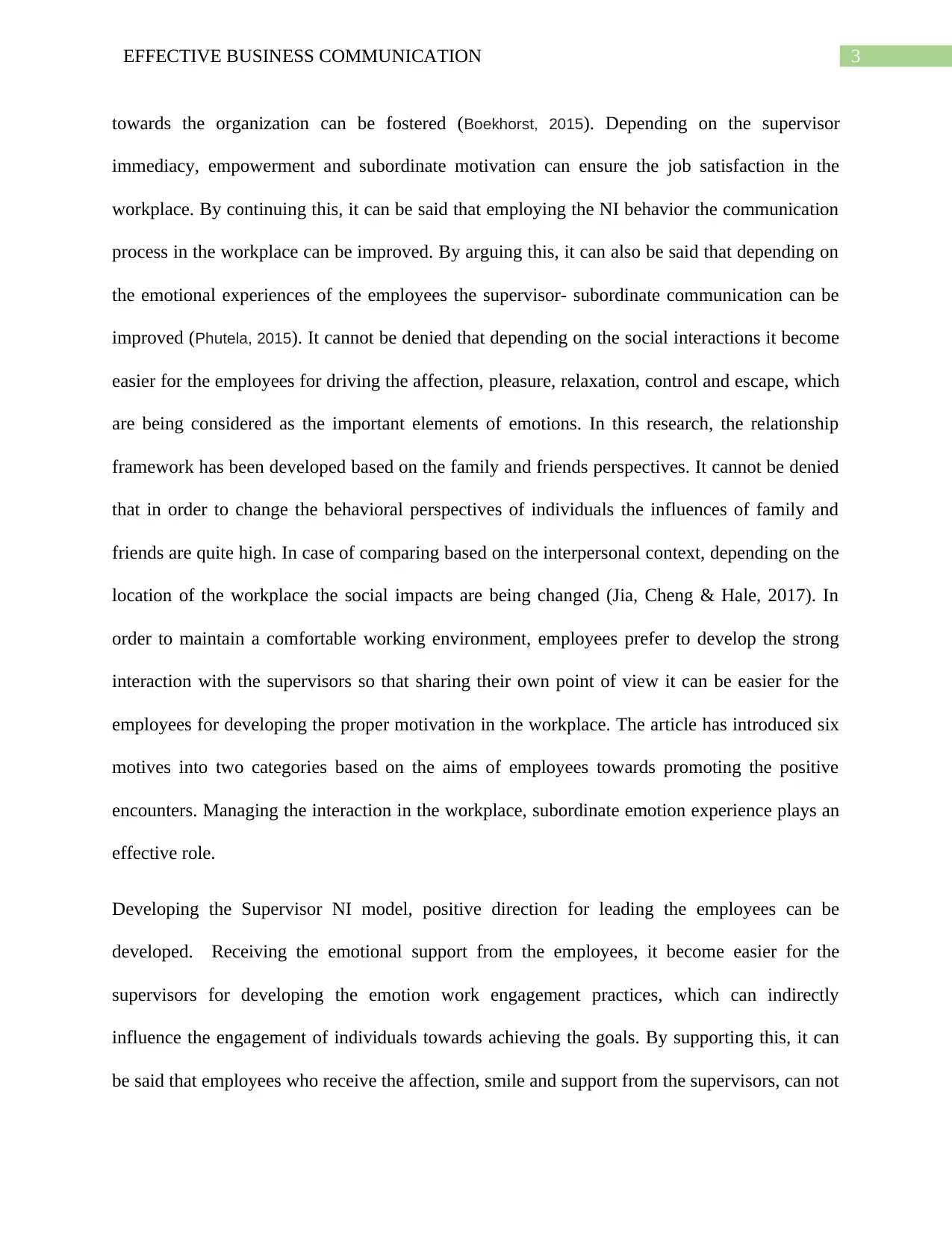
3EFFECTIVE BUSINESS COMMUNICATION
towards the organization can be fostered (Boekhorst, 2015). Depending on the supervisor
immediacy, empowerment and subordinate motivation can ensure the job satisfaction in the
workplace. By continuing this, it can be said that employing the NI behavior the communication
process in the workplace can be improved. By arguing this, it can also be said that depending on
the emotional experiences of the employees the supervisor- subordinate communication can be
improved (Phutela, 2015). It cannot be denied that depending on the social interactions it become
easier for the employees for driving the affection, pleasure, relaxation, control and escape, which
are being considered as the important elements of emotions. In this research, the relationship
framework has been developed based on the family and friends perspectives. It cannot be denied
that in order to change the behavioral perspectives of individuals the influences of family and
friends are quite high. In case of comparing based on the interpersonal context, depending on the
location of the workplace the social impacts are being changed (Jia, Cheng & Hale, 2017). In
order to maintain a comfortable working environment, employees prefer to develop the strong
interaction with the supervisors so that sharing their own point of view it can be easier for the
employees for developing the proper motivation in the workplace. The article has introduced six
motives into two categories based on the aims of employees towards promoting the positive
encounters. Managing the interaction in the workplace, subordinate emotion experience plays an
effective role.
Developing the Supervisor NI model, positive direction for leading the employees can be
developed. Receiving the emotional support from the employees, it become easier for the
supervisors for developing the emotion work engagement practices, which can indirectly
influence the engagement of individuals towards achieving the goals. By supporting this, it can
be said that employees who receive the affection, smile and support from the supervisors, can not
towards the organization can be fostered (Boekhorst, 2015). Depending on the supervisor
immediacy, empowerment and subordinate motivation can ensure the job satisfaction in the
workplace. By continuing this, it can be said that employing the NI behavior the communication
process in the workplace can be improved. By arguing this, it can also be said that depending on
the emotional experiences of the employees the supervisor- subordinate communication can be
improved (Phutela, 2015). It cannot be denied that depending on the social interactions it become
easier for the employees for driving the affection, pleasure, relaxation, control and escape, which
are being considered as the important elements of emotions. In this research, the relationship
framework has been developed based on the family and friends perspectives. It cannot be denied
that in order to change the behavioral perspectives of individuals the influences of family and
friends are quite high. In case of comparing based on the interpersonal context, depending on the
location of the workplace the social impacts are being changed (Jia, Cheng & Hale, 2017). In
order to maintain a comfortable working environment, employees prefer to develop the strong
interaction with the supervisors so that sharing their own point of view it can be easier for the
employees for developing the proper motivation in the workplace. The article has introduced six
motives into two categories based on the aims of employees towards promoting the positive
encounters. Managing the interaction in the workplace, subordinate emotion experience plays an
effective role.
Developing the Supervisor NI model, positive direction for leading the employees can be
developed. Receiving the emotional support from the employees, it become easier for the
supervisors for developing the emotion work engagement practices, which can indirectly
influence the engagement of individuals towards achieving the goals. By supporting this, it can
be said that employees who receive the affection, smile and support from the supervisors, can not
Paraphrase This Document
Need a fresh take? Get an instant paraphrase of this document with our AI Paraphraser
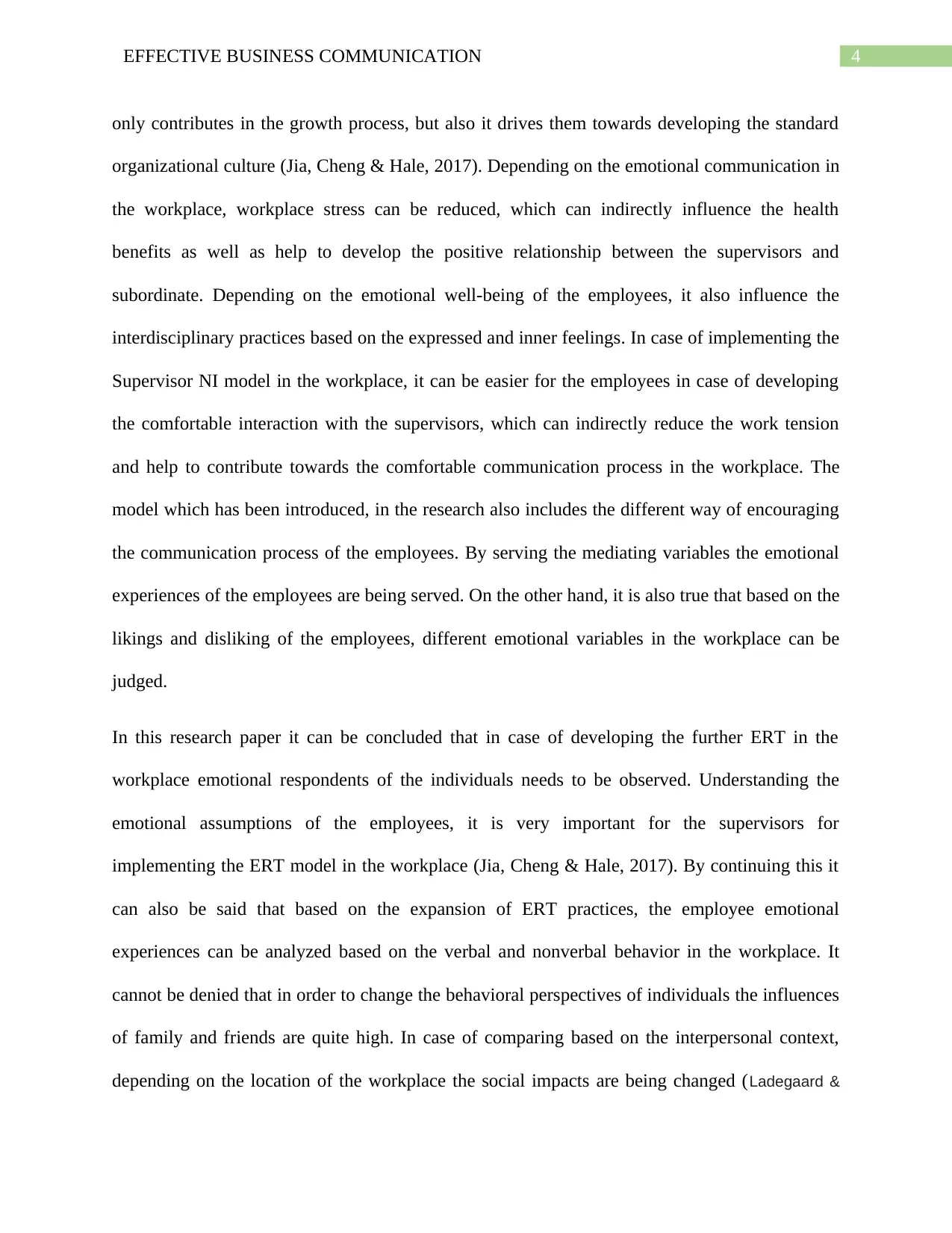
4EFFECTIVE BUSINESS COMMUNICATION
only contributes in the growth process, but also it drives them towards developing the standard
organizational culture (Jia, Cheng & Hale, 2017). Depending on the emotional communication in
the workplace, workplace stress can be reduced, which can indirectly influence the health
benefits as well as help to develop the positive relationship between the supervisors and
subordinate. Depending on the emotional well-being of the employees, it also influence the
interdisciplinary practices based on the expressed and inner feelings. In case of implementing the
Supervisor NI model in the workplace, it can be easier for the employees in case of developing
the comfortable interaction with the supervisors, which can indirectly reduce the work tension
and help to contribute towards the comfortable communication process in the workplace. The
model which has been introduced, in the research also includes the different way of encouraging
the communication process of the employees. By serving the mediating variables the emotional
experiences of the employees are being served. On the other hand, it is also true that based on the
likings and disliking of the employees, different emotional variables in the workplace can be
judged.
In this research paper it can be concluded that in case of developing the further ERT in the
workplace emotional respondents of the individuals needs to be observed. Understanding the
emotional assumptions of the employees, it is very important for the supervisors for
implementing the ERT model in the workplace (Jia, Cheng & Hale, 2017). By continuing this it
can also be said that based on the expansion of ERT practices, the employee emotional
experiences can be analyzed based on the verbal and nonverbal behavior in the workplace. It
cannot be denied that in order to change the behavioral perspectives of individuals the influences
of family and friends are quite high. In case of comparing based on the interpersonal context,
depending on the location of the workplace the social impacts are being changed (Ladegaard &
only contributes in the growth process, but also it drives them towards developing the standard
organizational culture (Jia, Cheng & Hale, 2017). Depending on the emotional communication in
the workplace, workplace stress can be reduced, which can indirectly influence the health
benefits as well as help to develop the positive relationship between the supervisors and
subordinate. Depending on the emotional well-being of the employees, it also influence the
interdisciplinary practices based on the expressed and inner feelings. In case of implementing the
Supervisor NI model in the workplace, it can be easier for the employees in case of developing
the comfortable interaction with the supervisors, which can indirectly reduce the work tension
and help to contribute towards the comfortable communication process in the workplace. The
model which has been introduced, in the research also includes the different way of encouraging
the communication process of the employees. By serving the mediating variables the emotional
experiences of the employees are being served. On the other hand, it is also true that based on the
likings and disliking of the employees, different emotional variables in the workplace can be
judged.
In this research paper it can be concluded that in case of developing the further ERT in the
workplace emotional respondents of the individuals needs to be observed. Understanding the
emotional assumptions of the employees, it is very important for the supervisors for
implementing the ERT model in the workplace (Jia, Cheng & Hale, 2017). By continuing this it
can also be said that based on the expansion of ERT practices, the employee emotional
experiences can be analyzed based on the verbal and nonverbal behavior in the workplace. It
cannot be denied that in order to change the behavioral perspectives of individuals the influences
of family and friends are quite high. In case of comparing based on the interpersonal context,
depending on the location of the workplace the social impacts are being changed (Ladegaard &
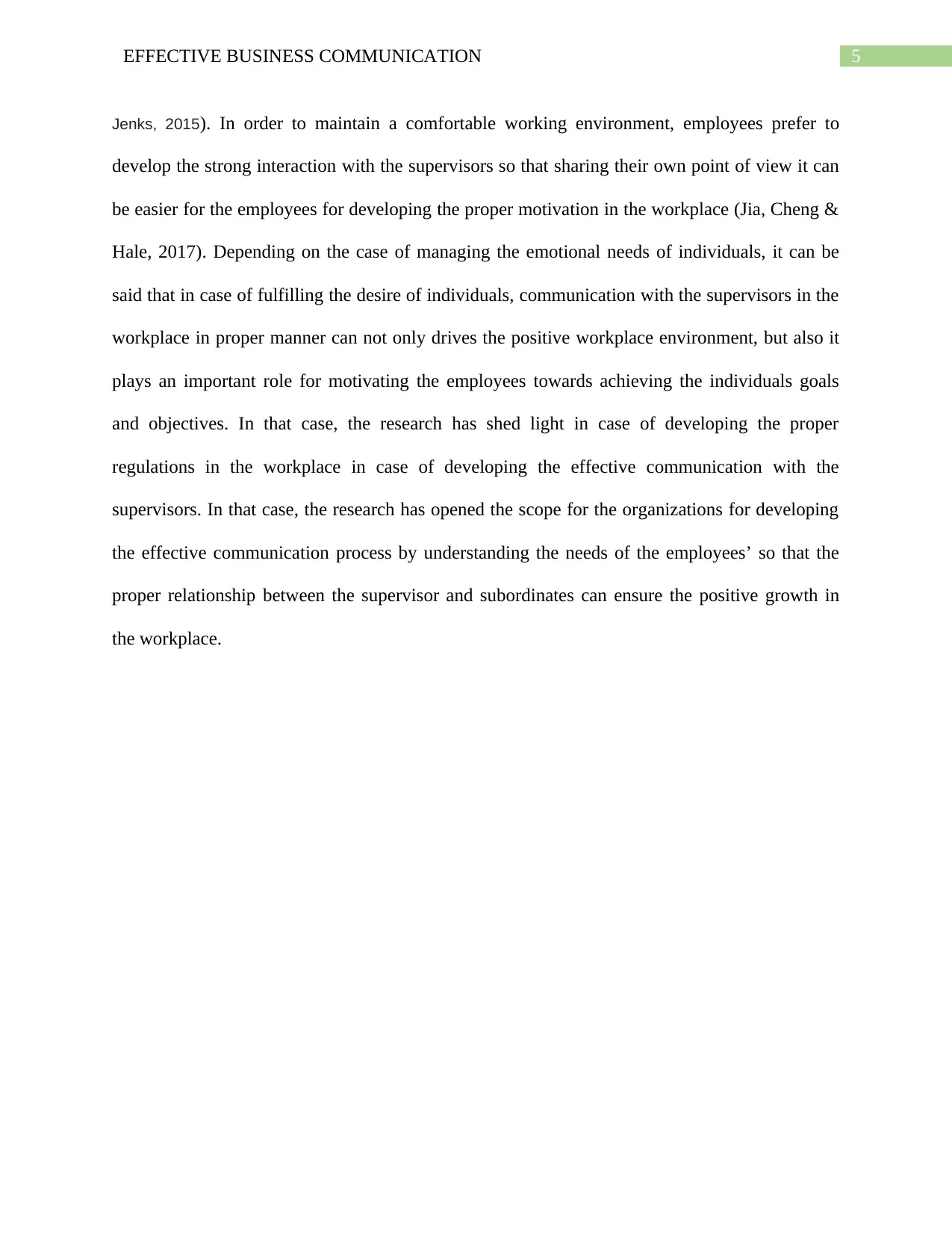
5EFFECTIVE BUSINESS COMMUNICATION
Jenks, 2015). In order to maintain a comfortable working environment, employees prefer to
develop the strong interaction with the supervisors so that sharing their own point of view it can
be easier for the employees for developing the proper motivation in the workplace (Jia, Cheng &
Hale, 2017). Depending on the case of managing the emotional needs of individuals, it can be
said that in case of fulfilling the desire of individuals, communication with the supervisors in the
workplace in proper manner can not only drives the positive workplace environment, but also it
plays an important role for motivating the employees towards achieving the individuals goals
and objectives. In that case, the research has shed light in case of developing the proper
regulations in the workplace in case of developing the effective communication with the
supervisors. In that case, the research has opened the scope for the organizations for developing
the effective communication process by understanding the needs of the employees’ so that the
proper relationship between the supervisor and subordinates can ensure the positive growth in
the workplace.
Jenks, 2015). In order to maintain a comfortable working environment, employees prefer to
develop the strong interaction with the supervisors so that sharing their own point of view it can
be easier for the employees for developing the proper motivation in the workplace (Jia, Cheng &
Hale, 2017). Depending on the case of managing the emotional needs of individuals, it can be
said that in case of fulfilling the desire of individuals, communication with the supervisors in the
workplace in proper manner can not only drives the positive workplace environment, but also it
plays an important role for motivating the employees towards achieving the individuals goals
and objectives. In that case, the research has shed light in case of developing the proper
regulations in the workplace in case of developing the effective communication with the
supervisors. In that case, the research has opened the scope for the organizations for developing
the effective communication process by understanding the needs of the employees’ so that the
proper relationship between the supervisor and subordinates can ensure the positive growth in
the workplace.
⊘ This is a preview!⊘
Do you want full access?
Subscribe today to unlock all pages.

Trusted by 1+ million students worldwide
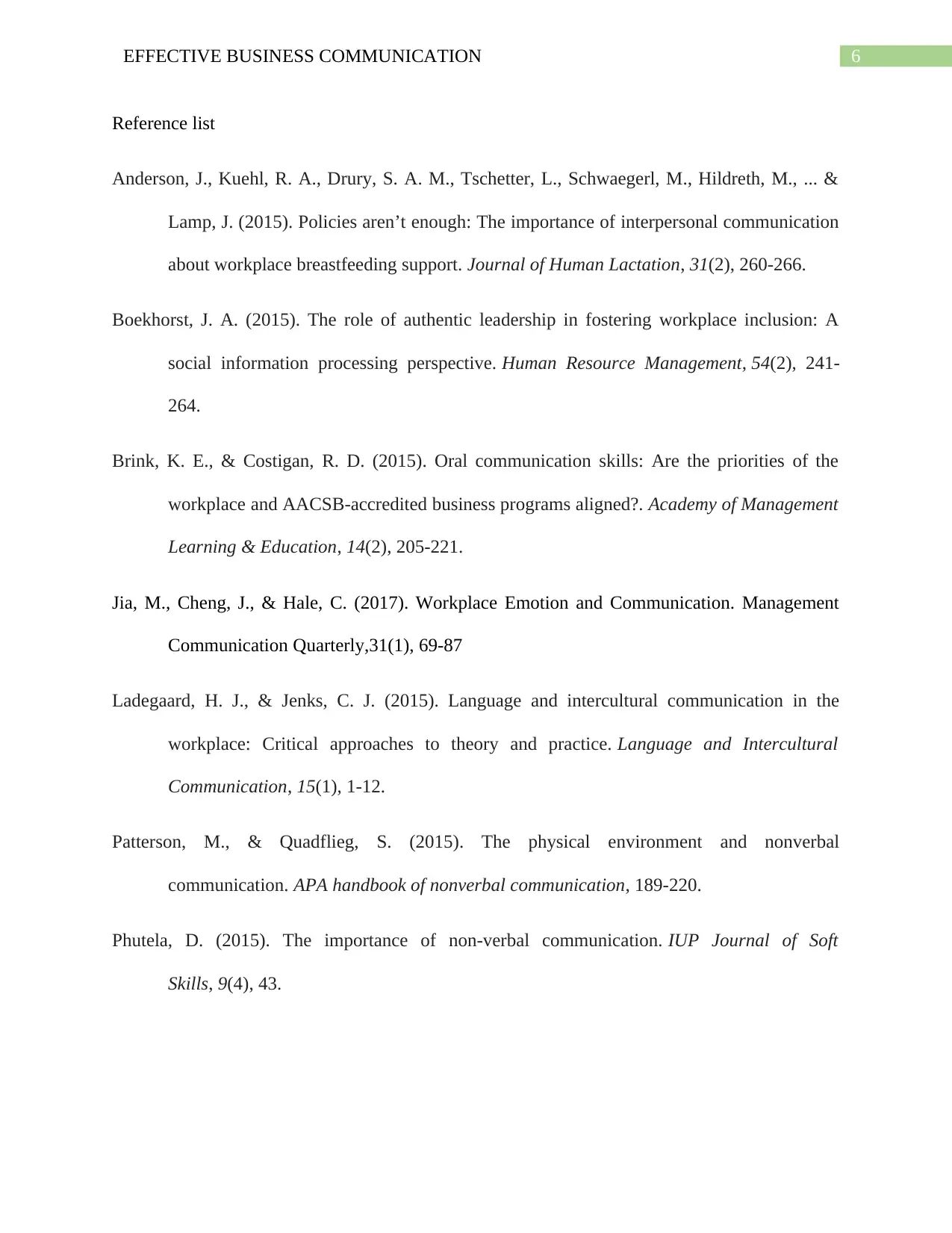
6EFFECTIVE BUSINESS COMMUNICATION
Reference list
Anderson, J., Kuehl, R. A., Drury, S. A. M., Tschetter, L., Schwaegerl, M., Hildreth, M., ... &
Lamp, J. (2015). Policies aren’t enough: The importance of interpersonal communication
about workplace breastfeeding support. Journal of Human Lactation, 31(2), 260-266.
Boekhorst, J. A. (2015). The role of authentic leadership in fostering workplace inclusion: A
social information processing perspective. Human Resource Management, 54(2), 241-
264.
Brink, K. E., & Costigan, R. D. (2015). Oral communication skills: Are the priorities of the
workplace and AACSB-accredited business programs aligned?. Academy of Management
Learning & Education, 14(2), 205-221.
Jia, M., Cheng, J., & Hale, C. (2017). Workplace Emotion and Communication. Management
Communication Quarterly,31(1), 69-87
Ladegaard, H. J., & Jenks, C. J. (2015). Language and intercultural communication in the
workplace: Critical approaches to theory and practice. Language and Intercultural
Communication, 15(1), 1-12.
Patterson, M., & Quadflieg, S. (2015). The physical environment and nonverbal
communication. APA handbook of nonverbal communication, 189-220.
Phutela, D. (2015). The importance of non-verbal communication. IUP Journal of Soft
Skills, 9(4), 43.
Reference list
Anderson, J., Kuehl, R. A., Drury, S. A. M., Tschetter, L., Schwaegerl, M., Hildreth, M., ... &
Lamp, J. (2015). Policies aren’t enough: The importance of interpersonal communication
about workplace breastfeeding support. Journal of Human Lactation, 31(2), 260-266.
Boekhorst, J. A. (2015). The role of authentic leadership in fostering workplace inclusion: A
social information processing perspective. Human Resource Management, 54(2), 241-
264.
Brink, K. E., & Costigan, R. D. (2015). Oral communication skills: Are the priorities of the
workplace and AACSB-accredited business programs aligned?. Academy of Management
Learning & Education, 14(2), 205-221.
Jia, M., Cheng, J., & Hale, C. (2017). Workplace Emotion and Communication. Management
Communication Quarterly,31(1), 69-87
Ladegaard, H. J., & Jenks, C. J. (2015). Language and intercultural communication in the
workplace: Critical approaches to theory and practice. Language and Intercultural
Communication, 15(1), 1-12.
Patterson, M., & Quadflieg, S. (2015). The physical environment and nonverbal
communication. APA handbook of nonverbal communication, 189-220.
Phutela, D. (2015). The importance of non-verbal communication. IUP Journal of Soft
Skills, 9(4), 43.
1 out of 7
Related Documents
Your All-in-One AI-Powered Toolkit for Academic Success.
+13062052269
info@desklib.com
Available 24*7 on WhatsApp / Email
![[object Object]](/_next/static/media/star-bottom.7253800d.svg)
Unlock your academic potential
Copyright © 2020–2025 A2Z Services. All Rights Reserved. Developed and managed by ZUCOL.





